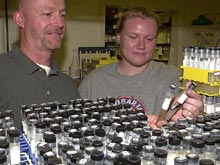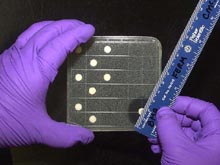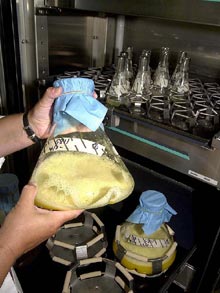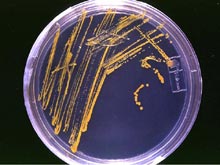
Harbor Branch Oceanographic Institution has more than 16,000 cultures of microbes isolated from deep- and shallow-water marine organisms. Click image for larger view.
Microbiology At Sea
Peter McCarthy and Kathleen Janda
Division of Biomedical Marine Research
Harbor Branch Oceanographic Institution
Marine invertebrates, such as sponges, are hosts to a large community of microorganisms, such as bacteria and fungi. In some cases, as much as 50% of the mass of the sponge may be microorganisms. These symbiotic microbes produce some of the bioactive chemicals found in marine organisms and are, therefore, a very valuable resource for drug discovery. It is necessary to culture these bacteria and fungi in order to study them. This process starts at sea and continues for many months after they are returned to laboratories at Harbor Branch Oceanographic Institution.
Immediately after the submersible returns to the ship, samples collected during the dive are taken into the vessel's "wet lab." The microbiologist takes a small sample of the organism (e.g., sponge, gorgonian, tunicate) to be used for microbial isolation work. At the same time a small sample of the organism is cryopreserved (deep frozen) at -80ºC, using a solution of glycerol and seawater as a cryoprotectant (to prevent the cells from being damaged by ice crystals). Back at the laboratories, these samples will be used to isolate microbes.
The sample is ground with sterile seawater, dilutions are made, and a small volume (50 microliters) of this suspension is placed on the surface of growth media in Petri dishes. Many types of growth media are used, depending on the type of microbe being isolated. The Petri dishes are sealed to prevent drying out of the growth media, and incubated at room temperature for periods lasting 2 weeks to several months. After the incubation period, dozens of colonies may grow on each plate. The colonies are then "picked" and streaked onto another plate until a single type of microorganism growing on a plate -- a pure culture -- is obtained. The culture is then characterized using properties such as the color, size and shape of the colonies, the size and shape of individual cells, and properties of the cells.
Once a pure culture has been characterized, it is preserved as part of the Harbor Branch Marine Microbial Culture Collection, which presently contains approximately 16,000 isolates. Cultures are frozen at -80º C for long-term storage, which ensures that the microbes are available for study for many years. Additional cultures are stored at 25º C as "working stocks."

This bioassay plate detects anti-microbial activity. Small disks of blotter paper are dipped in marine- organism extracts and placed on an agar plate with various bacteria. The clear zone indicates that the extracts are inhibiting microbial growth. Click image for larger view.
The process of drug discovery can then begin. The isolates are used to inoculate (introduce a microorganism into) flasks containing growth media that have been designed to allow both the growth of these unusual microbes and the production of bioactive compounds. After a growth period from 3 days to 2 weeks, during which the cultures are shaken to allow oxygen to reach the cells, the cultures are extracted using an organic solvent such as ethyl acetate. Many of the compounds produced by the microbes are more soluble in the solvent than in the growth medium and are, therefore, “extracted." The extracts are then tested for their biological activity using a variety of tests (assays) that are designed to identify potential drugs to treat cancer and infectious diseases.























